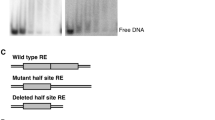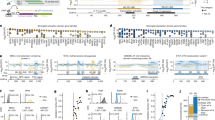Abstract
Changes in promoter specificity and binding affinity that may be associated with p53 mutations or post-translational modifications are useful in understanding p53 structure/function relationships and categorizing tumor mutations. We have exploited variable expression of human p53 in yeast to identify mutants with novel phenotypes that would correspond to altered promoter selectivity and affinity. The p53 cDNA regions coding for the DNA binding and tetramerization domains were subjected to random PCR mutagenesis and were cloned directly by recombination in yeast into a vector with a GAL1 promoter whose level of expression could be easily varied. p53 variants exhibiting higher than wild type levels of transactivation (supertrans) for the RGC responsive element were identified at low level of p53 protein expression. All the p53 mutants obtained with this screen were located in the DNA binding domain. Two out of 17 supertrans mutants have been found in tumors. Six mutations were in the L1 loop region between amino acids 115 and 124. The transactivation potential of a panel of supertrans p53 mutants on different promoters was evaluated using the p53 responsive elements, RGC, PIG3, p21 and bax. Although all mutants retained some activity with all promoters, we found different patterns of induction based on strength and promoter specificity. In particular none of the mutants was supertrans for the p21 responsive element. Interestingly, further analysis in yeast showed that the transactivation function could be retained even in the presence of dominant-negative p53 tumor mutations that could inhibit wild type p53. Five mutants were also characterized in human cells in terms of growth suppression and transactivation of various promoters. These novel supertrans p53 mutants may be useful in studies aimed at dissecting p53 downstream pathways, understanding specific interactions between p53 and the DNA, and could replace wild type p53 in cancer gene therapy protocols. The approach may also prove useful in identifying p53 tumor mutations.
This is a preview of subscription content, access via your institution
Access options
Subscribe to this journal
Receive 50 print issues and online access
$259.00 per year
only $5.18 per issue
Buy this article
- Purchase on Springer Link
- Instant access to full article PDF
Prices may be subject to local taxes which are calculated during checkout








Similar content being viewed by others
References
Aurelio ON, Kong XT, Gupta S and Stanbridge EJ. . 2000 Mol. Cell. Biol. 20: 770–778.
Brachmann RK, Vidal M and Boeke JD. . 1996 Proc. Natl. Acad. Sci. USA 93: 4091–4095.
Brachmann RK, Yu K, Eby Y, Pavletich NP and Boeke JD. . 1998 EMBO J. 17: 1847–1859.
Bullock AN, Henckel J, DeDecker BS, Johnson CM, Nikolova PV, Proctor MR, Lane DP and Fersht AR. . 1997 Proc. Natl. Acad. Sci. USA 94: 14338–14342.
Bullock AN, Henckel J and Fersht AR. . 2000 Oncogene 19: 1245–1256.
Chappuis PO, Estreicher A, Dieterich B, Bonnefoi H, Otter M, Sappino AP and Iggo R. . 1999 Int. J. Cancer. 84: 587–593.
Cho Y, Gorina S, Jeffrey PD and Pavletich NP. . 1994 Science 265: 346–355.
Cortes U, Moyret-Lalle C, Falette N, Duriez C, Ghissassi FE, Barnas C, Morel AP, Hainaut P, Magaud JP and Puisieux A. . 2000 Mol. Carcinog. 27: 57–64.
Di Como CJ and Prives C. . 1998 Oncogene 16: 2527–2539.
Flaman JM, Frebourg T, Moreau V, Charbonnier F, Martin C, Chappuis P, Sappino AP, Limacher IM, Bron L, Benhattar J and Iggo R. . 1995 Proc. Natl. Acad. Sci. USA 92: 3963–3967.
Flaman JM, Robert V, Lenglet S, Moreau V, Iggo R and Frebourg T. . 1998 Oncogene 16: 1369–1372.
Ferrin TE, Huang CC, Jarvis LE and Langridge R. . 1988 J. Mol. Graphics 6: 2–12.
Foster BA, Coffey HA, Morin MJ and Rastinejad F. . 1999 Science 286: 2507–2510.
Frazier MW, He X, Wang J, Gu Z, Cleveland JL and Zambetti GP. . 1998 Mol. Cell. Biol. 18: 3735–3743.
Frebourg T, Sadelain M, Ng YS, Kassel J and Friend SH. . 1994 Cancer. Res. 54: 878–881.
Freeman J, Schmidt S, Scharer E and Iggo R. . 1994 EMBO J. 13: 5393–5400.
Friedlander P, Haupt Y, Prives C and Oren M. . 1996 Mol. Cell. Biol. 16: 4961–4971.
Gagnebin J, Kovar H, Kajava AV, Estreicher A, Jug G, Monnier P and Iggo R. . 1998 Oncogene 16: 685–690.
Gallagher WM and Brown R. . 1999 Ann. Oncol. 10: 139–150.
Giaccia AJ and Kastan MB. . 1998 Genes Dev. 12: 2973–2983.
Gostissa M, Hengstermann A, Fogal V, Sandy P, Schwarz SE, Scheffner M and Del Sal G. . 1999 EMBO J. 18: 6462–6471.
Greenblatt MS, Bennett WP, Hollstein M and Harris CC. . 1994 Cancer. Res. 54: 4855–4878.
Guex N and Peitsch MC. . 1997 Electrophoresis 18: 2714–2723.
Hernandez-Boussard T, Rodriguez-Tome P, Montesano R and Hainaut P. . 1999 Hum. Mutat. 14: 1–8.
Huxley C, Green ED and Dunham I. . 1990 Trends Genet. 6: 236.
Inga A, Cresta S, Monti P, Aprile A, Scott G, Abbondandolo A, Iggo R and Fronza G. . 1997a Carcinogenesis 18: 2019–2021.
Inga A, Iannone R, Monti P, Molina F, Bolognesi M, Abbondandolo A, Iggo R and Fronza G. . 1997b Oncogene 14: 1307–1313.
Ishioka C, Englert C, Winge P, Yan YX, Engelstein M and Friend SH. . 1995 Oncogene 10: 1485–1492.
Kern SE, Pietenpol JA, Thiagalingam S, Seymour A, Kinzler KW and Vogelstein B. . 1992 Science 256: 827–830.
Ko LJ and Prives C. . 1996 Genes Dev. 10: 1054–1072.
Komarov PG, Komarova EA, Kondratov RV, Christov-Tselkov K, Coon JS, Chernov MV and Gudkov AV. . 1999 Science 285: 1733–1737.
Lin J, Teresky AK and Levine AJ. . 1995 Oncogene 10: 2387–2390.
Ludwig RL, Bates S and Vousden KH. . 1996 Mol. Cell. Biol. 16: 4952–4960.
May P and May E. . 1999 Oncogene 18: 7621–7636.
McLure KG and Lee PW. . 1999 EMBO J. 18: 763–770.
Meek DW. . 1998 Int. J. Radiat. Biol. 74: 729–737.
Nikolova PV, Henckel J, Lane DP and Fersht AR. . 1998 Proc. Natl. Acad. Sci. USA 95: 14675–14680.
Nikolova PV, Wong KB, DeDecker B, Henckel J and Fersht AR. . 2000 EMBO J. 19: 370–378.
Okaichi K, Wang LH, Sasaki J, Saya H, Tada M and Okumura Y. . 1999 Int. J. Radiat. Oncol. Biol. Phys. 45: 975–980.
Oren M. . 1999 J. Biol. Chem. 274: 36031–36034.
Pan Y and Haines DS. . 2000 Oncogene 19: 3095–3100.
Prives C and Hall PA. . 1999 J. Pathol. 187: 112–126.
Reis AM, Cheo DL, Meira LB, Greenblatt MS, Bond JP, Nahari D and Friedberg EC. . 2000 Cancer Res. 60: 1571–1579.
Robert V, Michel P, Flaman JM, Chiron A, Martin C, Charbonnier F, Paillot B and Frebourg T. . 2000 Carcinogenesis 21: 563–565.
Saller E, Tom E, Brunori M, Otter M, Estreicher A, Mack DH and Iggo R. . 1999 EMBO J. 18: 4424–4437.
Scharer E and Iggo R. . 1992 Nucleic Acids Res. 20: 1539–1545.
Selivanova G, Ryabchenko L, Jansson E, Iotsova V and Wiman KG. . 1999 Mol. Cell. Biol. 19: 3395–3402.
Shimada A, Kato S, Enjo K, Osada M, Ikawa Y, Kohno K, Obinata M, Kanamaru R, Ikawa S and Ishioka C. . 1999 Cancer Res. 59: 2781–2786.
Smith PD, Crossland S, Parker G, Osin P, Brooks L, Waller J, Philp E, Crompton MR, Gusterson BA, Allday MJ and Crook T. . 1999 Oncogene 18: 2451–2459.
Soussi T and May P. . 1996 J. Mol. Biol. 260: 623–637.
Stommel JM, Marchenko ND, Jimenez GS, Moll UM, Hope TJ and Wahl GM. . 1999 EMBO J. 18: 1660–1672.
Swisher SG, Roth JA, Nemunaitis J, Lawrence DD, Kemp BL, Carrasco CH, Connors DG, El-Naggar AK, Fossella F, Glisson BS, Hong WK, Khuri FR, Kurie JM, Lee JJ, Lee JS, Mack M, Merritt JA, Nguyen DM, Nesbitt JC, Perez-Soler R, Pisters KM, Putnam Jr. JB, Richli WR, Savin M & Savin Waugh MK. . 1999 J. Natl. Cancer Inst. 91: 763–771.
Tanaka H, Arakawa H, Yamaguchi T, Shiraishi K, Fukuda S, Matsui K, Takei Y and Nakamura Y. . 2000 Nature 404: 42–49.
Thornborrow EC and Manfredi JJ. . 1999 J. Biol. Chem. 274: 33747–33756.
Venot C, Maratrat M, Dureuil C, Conseiller E, Bracco L and Debussche L. . 1998 EMBO J. 17: 4668–4679.
Vinyals A, Peinado MA, Gonzalez-Garrigues M, Monzo M, Bonfil RD and Fabra A. . 1999 Gene Ther. 6: 2233.
Walker DR, Bond JP, Tarone RE, Harris CC, Makalowski W, Boguski MS and Greenblatt MS. . 1999 Oncogene 18: 211–218.
Acknowledgements
Our thanks to Drs Richard Iggo, Bert Vogelstein, Moshe Oren, and Thiery Frebourg for the generous gifts of expression vectors and yeast strains and to Drs Robert Slebos, Dmitry Gordenin, Francesca Storici, Kevin Lewis, Alex Merrick, Anna Aprile, Paola Campomenosi and Angelo Abbondandolo for advice, helpful discussions and comments on the manuscript. Alberto Inga was supported by a Fellowship from the American Italian Cancer Foundation and by an NIH Courtesy Contract; Paola Monti was supported by an Italian Cancer Research Foundation Fellowship.
Author information
Authors and Affiliations
Rights and permissions
About this article
Cite this article
Inga, A., Monti, P., Fronza, G. et al. p53 mutants exhibiting enhanced transcriptional activation and altered promoter selectivity are revealed using a sensitive, yeast-based functional assay. Oncogene 20, 501–513 (2001). https://doi.org/10.1038/sj.onc.1204116
Received:
Revised:
Accepted:
Published:
Issue Date:
DOI: https://doi.org/10.1038/sj.onc.1204116



